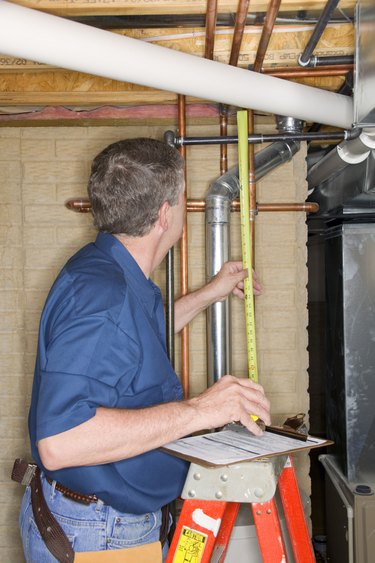
Bathroom renovation and design usually include a bath or shower, and walk-in showers require a shower pan. Whether mud-set or fiberglass, shower pans must be waterproof and slope slightly toward the drain to prevent standing water. Shower walls are installed after the pan, and they overlap the rim to prevent water leaks. Determine your budget, level of skill and the integrity of your home's structure to help you decide which shower pan is right for you.
Mud-Set Shower Pans
Video of the Day
Mud-set shower pans, often called mortar beds, are made from cement mortar, and they are created in a multi-step process on-site. You must frame the perimeter of the shower, install a flexible, waterproof membrane and pour the mortar into the bottom of the frame around the drain pipe. Metal mesh or rods are sometimes placed in the frame before pouring the mortar to add strength. Skilled craftspeople can make the job look easy, but there are many special techniques involved. Although mud-set shower pans are functional once the mortar dries, they are usually installed as a tile foundation.
Video of the Day
Pros and Cons of Mortar Beds
Cement is sometimes called man-made stone, and it is a large component of mortar. It is not harmed by water, but it also doesn't repel it. It dries to a heavy, rigid material. Floors may require additional support under a mud-set shower pan, especially upper floors. If reinforcing wire or rods are not used, the mortar can crack. Cracked cement can tear the waterproof membrane underneath, which allows water to seep into the floor or walls. A unnoticed leak can cause serious structural damage to your home and encourage mold growth in the walls. Even if it feels dry to the touch, a mud-set shower pan should ideally be left to dry for several weeks before using. Slow curing makes the shower pan stronger.
Fiberglass Shower Pans
Fiberglass shower pans are available off the shelf at home improvement centers in a range of common sizes. White and almond are typical colors, although some companies can manufacture one to your size and color specifications. Fiberglass is often slick when wet, so many shower pans have a nubby or ridged floor to help with traction. Fiberglass materials are molded into seamless units, complete with a drain opening. Raised sides help contain water, and there is a predetermined slope for drainage. Basic installation requires leveling the pan using wedge shims underneath, screwing it to the studs with water-resistant screws and connecting the drain.
Pros and Cons of Fiberglass
Fiberglass shower pans can allow a handy person with plumbing skills to install one without a contractor. The material is lighter than concrete, so floors may not need reinforcement. However, some shower pans aren't rigid and require a solid mortar base (see References 4, paragraph 9). Although fiberglass is strong, it can crack over time. Abrasive cleansers can scratch the finish. Scratched fiberglass holds dirt and soap scum, which makes it more difficult to clean than when it was new. This is an inconvenient situation for a shower floor, where dirt and other residue collect. Scrubbing to remove the residue can create more scratches. Ensure the sub floor is strong before installing a fiberglass shower pan to help prevent cracks. Clean the pan regularly with a non-abrasive cleaner made for fiberglass showers to help avoid deep scrubbing and scratches. If it becomes damaged, hire a professional who can make long-lasting, inconspicuous repairs.